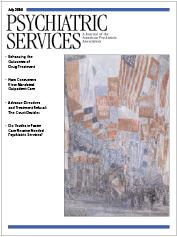Variables Associated With Hospitalization Decisions by Emergency Psychiatrists After a Patient's Suicide Attempt
Abstract
OBJECTIVE: This study explored the factors psychiatrists considered in deciding on hospitalization for a large sample of suicide attempters in the emergency department of a general hospital in Madrid, Spain, between 1996 and 1998. METHODS: Psychiatrists assessed 509 patients who had attempted suicide; 196 of these (39 percent) were hospitalized in the psychiatric unit, and 313 (61 percent) were discharged from the emergency department. The assessment included Beck's Suicidal Intent Scale (SIS) and a checklist of 47 clinical variables. RESULTS: Of the 32 clinical variables significantly associated with hospitalization that were introduced in a logistic regression model, 11 remained significant. Six variables were associated with an increased odds of hospitalization: intention to repeat the attempt, plan to use a lethal method, low psychosocial functioning before the suicide attempt, previous psychiatric hospitalization, a suicide attempt in the past year, and planning that nobody would try to save their life after they had attempted suicide. Five variables decreased the odds: a realistic perspective on the future after the attempt, relief that the attempt was not effective, availability of a method to kill oneself (that was not used), belief that the attempt would influence others, and family support. Models based on the SIS total score and individual SIS items had lower specificity and sensitivity. CONCLUSIONS: Psychiatrists appear to rely on patients' self-report in deciding on hospitalization rather than focus on demographic, diagnostic, or psychosocial issues. If the findings of this study were replicated in other hospital settings, the implication would be that the guidelines for assessing suicide attempts need to encourage thorough and detailed assessment of the attempt and the future plans.



